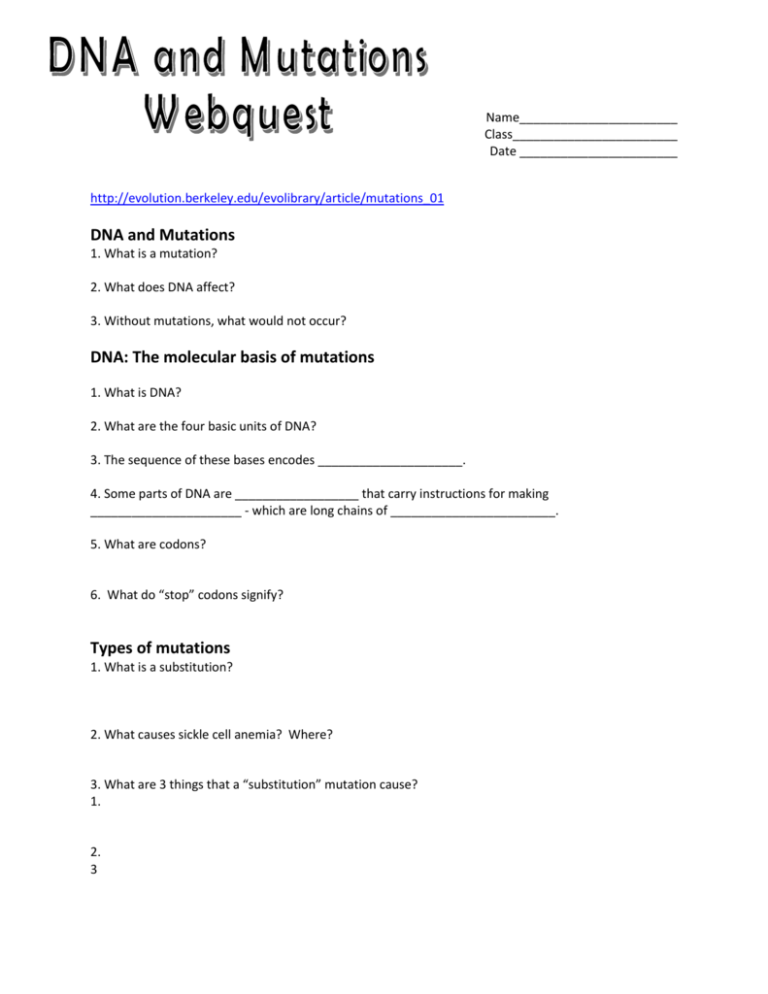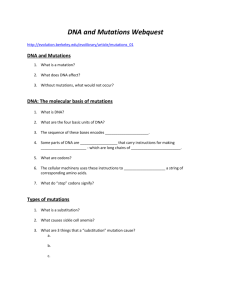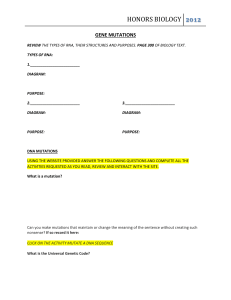DNA and Mutations
advertisement

Name_______________________ Class________________________ Date _______________________ http://evolution.berkeley.edu/evolibrary/article/mutations_01 DNA and Mutations 1. What is a mutation? 2. What does DNA affect? 3. Without mutations, what would not occur? DNA: The molecular basis of mutations 1. What is DNA? 2. What are the four basic units of DNA? 3. The sequence of these bases encodes _____________________. 4. Some parts of DNA are __________________ that carry instructions for making ______________________ - which are long chains of ________________________. 5. What are codons? 6. What do “stop” codons signify? Types of mutations 1. What is a substitution? 2. What causes sickle cell anemia? Where? 3. What are 3 things that a “substitution” mutation cause? 1. 2. 3 4. Copy the example of a substitution mutation. (left side of page) 5. What is an insertion mutation? 6. Copy the example of a insertion 7. What is a deletion? 8. Copy the deletion example: Causes of mutations 1. DNA fails to ______________ __________________. 2. External _____________________ can create _________________________. 3. What are two examples of external influences? 1. 2. The effects of mutations 1. Where may mutations occur? 2. What are somatic mutations? 3. What are the only types of mutations that matter to large-scale evolution? 4. What are the effects of germ line mutations? 1. 2. 3. 5. While many mutations do indeed have negative effects, mutations can have major (and _________________________________ ) effects. 6. What are Hox genes? 7. What is the effect of a mutation in the Hox gene? 8. Weird Fact: What happened to the fly with a Hox mutation? A case of the effects of mutation: Sickle cell mutation 1. What is sickle-cell anemia? 2. People with _________ copies of the gene have the disease. 3. What are the effects of the sickle cell gene? 1. 2. 3. 4. 5. 4. What are some of the positive effects of sickle cell? Mutations are Random 1. Mutations can be _________________, neutral, or _________________ to the organism. 2. What are two possible explanations for “resistant” lice? 3. What is directed mutation? 4. In 1952, Esther and Joshua Lederberg performed and experiment that helped show . . . 5. What was their hypothes? 7. So, the penicillin-resistant bacteria were there in the ________________________ before they encountered _________________________. They did not _________________________ resistance in response to the exposure to the _____________________________.









